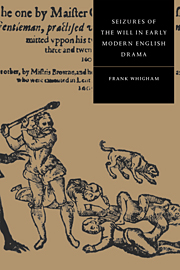Book contents
- Frontmatter
- Contents
- Acknowledgments
- Abbreviations
- Introduction
- 1 Forcing divorce in The Spanish Tragedy
- 2 Hunger and pain in Arden of Faversham
- 3 The ideology of prodigality in The Miseries of Enforced Marriage and A Yorkshire Tragedy
- 4 Sexual and social mobility in The Duchess of Malfi
- Afterword
- Notes
- Works cited
- Index
1 - Forcing divorce in The Spanish Tragedy
Published online by Cambridge University Press: 17 August 2009
- Frontmatter
- Contents
- Acknowledgments
- Abbreviations
- Introduction
- 1 Forcing divorce in The Spanish Tragedy
- 2 Hunger and pain in Arden of Faversham
- 3 The ideology of prodigality in The Miseries of Enforced Marriage and A Yorkshire Tragedy
- 4 Sexual and social mobility in The Duchess of Malfi
- Afterword
- Notes
- Works cited
- Index
Summary
Thomas Kyd's Spanish Tragedy provides an essential beginning for studying how fantasies of power and control and achieved security work within and against the social constraints of early modern English culture. This play thematizes such seizures, and its events are not just instantiations of these categories, but often their founding moments. Kyd first troped and mapped what later became the obsessive landscape of Renaissance courtly tragedy. Such exemplary status has long been noted regarding Hieronymo's revenge, the originary gesture of Elizabethan revenge tragedy. This aspect of The Spanish Tragedy has subsumed most inquiry into the play. However, my discussion will minimize questions about Hieronymo and revenge, focusing instead on the play's first movement, the complex events of Acts 1 and 2 that end with Horatio's murder. I hope to revalue what Philip Edwards, speaking for many readers, calls these “prolix early scenes” that seem “so laboured”: “few readers fail to find the early scenes tedious,” he feels, and many agree. I don't. A close look at the complex events and conditions that authorize Hieronymo's revenge can be very useful in unpacking impacted nodes of social pain which Kyd discovered Elizabethans needed, and loved, to confront.
Over and over The Spanish Tragedy emphasizes adversarial presentation. Lorenzo strives to control his sister Bel-imperia's erotic agency, and she, just as strongly, to invest it as and when she will. Noble Lorenzo and Balthazar struggle to dominate what they feel to be the poachings of ambitious gentlemen like Andrea and Horatio.
- Type
- Chapter
- Information
- Seizures of the Will in Early Modern English Drama , pp. 22 - 62Publisher: Cambridge University PressPrint publication year: 1996



